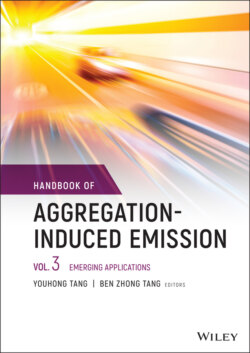Читать книгу Handbook of Aggregation-Induced Emission, Volume 3 - Группа авторов - Страница 17
1.2.2 Green Aggregation‐induced Emissive Emitters
ОглавлениеIn comparison to their blue and red counterparts, green AIEgens are quite facile to design, with suitable conjugated length and polarity. In this section, we exemplify the green AIE emitters sorted by nonpolar and polar emitter. Tanyeli et al. attached three peripheral moieties of indole, tert‐butylcarbazole, and tetrahydrocarbazole to the TPE core, to obtain TIPE, TTBCPE, and TDCPE (Figure 1.3), respectively, through two facile steps. Based on these emitters, nondoped green OLED devices with different constructions could be prepared with a maximum brightness, CE, and EQE of 18 000 cd/m2, 7.7 cd/A, and 3.2%, respectively [61]. By the same method, they further took advantage of another four N‐heteroaromatic rings to attach the TPE cores, and the AIE emitters were therefore prepared, based on which green OLED devices could be prepared and exhibited relatively lower EL performance, with brightness, CE, and EQE of 2600 cd/m2, 3.6 cd/A, and 1.5%, respectively [62]. Similarly, Tang et al. used the well‐known and hole‐transporting materials of NPB to covalently integrate to the TPE core, with the resulted TPE‐NPB as a green AIEgen (Figure 1.3). Using TPE‐NPB as emitters, nondoped green OLED devices were fabricated, with maximum luminance and CE of 11 981 cd/m2 and 11.9 cd/A, respectively [63]. Still some other nonpolar green emitters were reported. Lu and Wang et al. tethered 2‐aryl‐3‐cyanobenzofuran fluorophore with TPE core via 5‐, 6‐, and 7‐position of 2‐aryl‐3‐cyanobenzofuran, and its nondoped OLED devices were prepared with the structure of ITO/PEDOT : PSS (40 nm)/EML (60 nm)/TBPI (25 nm)/Ca (10 nm)/Ag (80 nm), where 6‐position substituted emitter‐based OLEDs exhibited the best performance with brightness, CE, PE, and EQE of 620 cd/m2, 1.62 cd/A, 0.73 lm/W, and 0.63%, respectively [64]. Silole moiety was also adopted as effective building units to construct the green AIE‐active emitters, simply by increasing the conjugating length. For example, Zhao et al. designed and prepared three novel green‐emissive AIE‐active silole derivatives 2,2′‐MTPS‐CaP, 3,3′‐MTPS‐CaP, and 9,9′‐MTPS‐CaP (Figure 1.3) by connecting silole and electron‐donating groups of 9‐phenyl‐9H‐carbazole through different linkage. And the OLEDs based on the emitter 9,9′‐MTPS‐CaP had the best EL performance, with the EQE of 5.63%, above the limit of 5% in traditional fluorescent OLEDs [65].
Figure 1.3 Molecular structures of green conventional AIE‐active emitters.
Green AIEgens of donor– π –acceptor (D– π –A) systems, with intramolecular charge transfer (ICT) from donor end to acceptor, also attracted great attention in molecule design and found broad applications in construction of OLEDs [66]. Tang et al. took diphenylamino and dimesitylboryl groups as donor and acceptor, respectively, to combine with the TPE core, and a series of AIE‐based star‐shaped bipolar TPE derivatives TPE‐2PN2PB, TPE‐PN3PB, and TPE‐4PB (Figure 1.3) were prepared with PLQY of up to 95% in the solid state. Based on these emitters, nondoped OLEDs through solution process were successfully fabricated, with the structure of ITO (130 nm)/PEDOT : PSS (40 nm)/EML (70 nm)/TPBi (30 nm)/Ba (4 nm)/Al (120 nm). These OLEDs showed peak luminance and EQE of 11 665 cd/m2 and 2.6%, respectively [67]. In another research, they introduced carbazole moiety with hole‐transporting property and dimesityl boron groups with electron‐transporting property as peripheries, into TPE core, to obtain two green AIE emitters of PDPBCE and BDPBCE (Figure 1.3). Based on these two emitters, nondoped OLEDs were fabricated with the structure of ITO/HATCN (10 nm)/NPB (50 nm)/EML (30 nm)/TPBi (40 nm)/LiF (1 nm)/Al (150 nm). Both the devices showed green‐light emission, with a maximum brightness of 67 500 cd/m2 and a maximum CE of 11.2 cd/A [68]. Furthermore, they applied N‐ethyl‐carbazole group, and dimesitylboron or (dimesitylboranyl)phenyl groups were attached TPE core and linked to the para‐ or meta‐position of TPE to obtain four AIE luminogens of p‐DPDECZ, p‐DBPDECZ, m‐DPDECZ, and m‐DBPDECZ (Figure 1.3). Compared to the meta‐linked, compound‐based blue OLEDs, the nondoped OLED devices with para‐linked compound exhibited better EL performance, with a maximum brightness of 30 210 cd/m2 and a maximum CE of 9.96 cd/A, due to the increased conjugated length [69].
